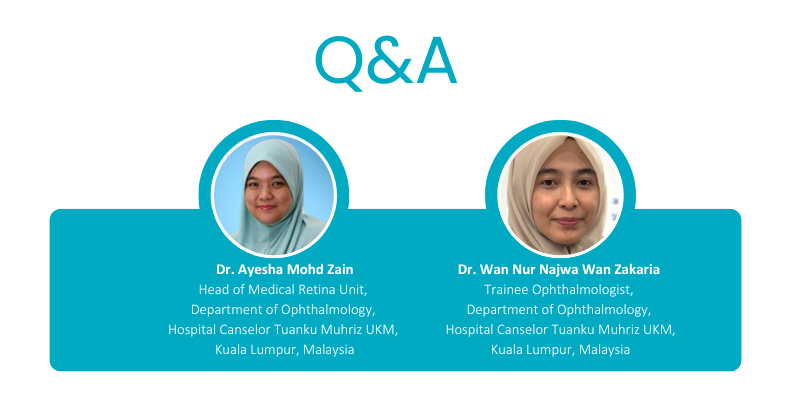HCTM-UKM marks World Retina Day with focus on AMD and DME
16 Oct 2025
Share
Age-related macular degeneration (AMD) and diabetic macular edema (DME) are two leading causes of vision loss worldwide.1,2 As early stages may progress silently, many patients only present once visual impairment has already set in.1 To address these challenges, Hospital Canselor Tuanku Muhriz UKM (HCTM-UKM) from Malaysia hosted “Retina Day” on 26 September 2025, in conjunction with World Retina Day and World Sight Day. The event featured lectures by Dr. Ayesha Mohd Zain, Head of the Medical Retina Unit, and Dr. Wan Nur Najwa Wan Zakaria, trainee ophthalmologist, who delved into early warning signs, risk factors, and emerging treatment strategies—underscoring the importance of timely detection and comprehensive patient care.
The retina, a light-sensitive layer at the back of the eye, converts visual information into neural signals for the brain.3 At its center lies the macula, responsible for sharp, detailed vision essential for tasks such as reading and driving.3 Degeneration of this area, as seen in AMD, can profoundly impair daily life.1 In dry AMD, declining retinal pigment epithelium (RPE) function with age leads to the accumulation of extracellular deposits known as drusen.1 These deposits reflect RPE stress, and progressive loss of RPE and photoreceptors eventually causes macular atrophy.1 Wet AMD, in contrast, is driven by hypoxia-induced vascular endothelial growth factor (VEGF), which stimulates abnormal vessel growth beneath the retina.1 These vessels are prone to leakage or bleeding, causing rapid central vision loss.1
“Patients often notice central vision distortion, wavy lines, subtle blurring or even loss of vision,” Dr. Ayesha explained, “and these symptoms should prompt immediate evaluation.” Age over 50, female sex, family history, smoking, and uncontrolled hypertension are among the key risk factors.1 Retinal imaging, such as optical coherence tomography (OCT) to differentiate dry from wet AMD, and fluorescein angiography to detect vascular leakage, are critical for accurate diagnosis.1 Intravitreal anti-VEGF injections remain the mainstay of wet AMD therapy, stabilizing or even improving vision.1 In select cases, photodynamic therapy may complement injections to address abnormal vessels.4 Preventive measures—including smoking cessation, blood pressure control, a nutrient-rich diet, regular exercise, and UV protection—are vital components of patient management.1,5
While AMD primarily affects older adults, DME represents a major threat to vision in patients with diabetes, capable of occurring at any stage of diabetic retinopathy.2 Chronic hyperglycemia damages retinal capillaries, making them leaky and impairing oxygen delivery.2 Ischemic stress triggers VEGF and other mediators, promoting the proliferation of abnormal, fragile vessels.2 Together, these processes lead to macular fluid accumulation, retinal thickening, and ultimately development of DME.2 This swelling is often painless, with progressive central vision blurring that delays recognition until significant damage has occurred. “Because DME is painless in its early stages, regular screening is essential for timely intervention,” Dr. Wan Nur Najwa highlighted. Patients with poorly controlled diabetes, hypertension, dyslipidemia, or advanced kidney disease face heightened risk. Regular dilated eye examinations, combined with optimal control of blood glucose, blood pressure, and cholesterol, are critical to preserving vision.2
Management strategies for DME are multifaceted.2 Intravitreal anti-VEGF therapy remains the cornerstone, reducing edema and improving outcomes, while corticosteroids are an option in selected cases.2 Focal or grid laser treatment may help stabilize macular function, and vitrectomy is reserved for abnormalities at the vitreoretinal interface perpetuate macular edema.2 Effective care, therefore, requires close coordination between ophthalmologists and primary care teams to address both ocular and systemic disease.2
In conclusion, AMD and DME remain leading contributors to irreversible vision loss–AMD affects millions worldwide, and diabetic retinopathy threatens one in three adults with diabetes, a substantial proportion of whom develop DME.1,2 Through public engagement and expert insights, “Retina Day” underscored the value of awareness and education as the first step toward prevention. Timely clinical intervention, coupled with patient empowerment, can ease the burden of these diseases and secure better long-term outcomes for at-risk populations.1,2
In an interview with Omnihealth Practice, Dr. Ayesha Mohd Zain and Dr. Wan Nur Najwa Wan Zakaria further shared their clinical insights on the management of age-related macular degeneration (AMD) and diabetic macular edema (DME).
Q1: What should clinicians emphasize for early detection and patient education?
Dr. Ayesha noted that early AMD can be asymptomatic, with subtle drusen—extracellular deposits—appearing in the macula. While drusen can occur elsewhere in the retina, those in the macula are most clinically significant because they can affect central vision. As the disease advances, patients may experience central vision blurring or image distortion. Key risk factors include age over 50, female sex, family history, smoking, and uncontrolled hypertension. “Adopting a healthy lifestyle, including a diet rich in colorful fruits and vegetables (e.g., berries, tomatoes), intake of omega-3–rich fish oils, regular exercise, UV protection, and smoking cessation are important preventive strategies,” she advised.
Dr. Wan Nur Najwa emphasized that DME is similarly silent in its early stages. Chronic hyperglycemia damages retinal capillaries, making them fragile and prone to leakage; areas of retinal ischemia then trigger VEGF and other mediators that increase vascular permeability. The net effect is fluid accumulation in the macula and central vision disturbance. Annual dilated eye examinations are essential for all patients with diabetes, even when vision appears normal, with follow-up frequency tailored to retinopathy stage and planned interventions.
Q2: What are the key treatment approaches and clinical challenges?
Both experts emphasized that intravitreal anti-VEGF injections remain the mainstay for wet AMD and for DME, reducing abnormal vessel growth, edema, and the risk of bleeding. In select cases, focal therapies may be used as adjuncts to injections (e.g., focal laser for certain polypoidal lesions in AMD, and focal/grid laser for persistent, localized leakage in DME). Dr. Ayesha noted that the treatment aims to reduce the macular edema, inactivate or shrink the abnormal vessels with the hope of improving vision and prevent scarring. Dr. Wan Nur Najwa also highlighted the importance of systemic control, particularly glucose and blood pressure management as integral to preventing progression.
Q3: How can multidisciplinary care optimize outcomes?
Dr. Ayesha and Dr. Wan Nur Najwa agreed that managing AMD and DME extends beyond ophthalmology. Coordinating with primary care to address comorbidities, alongside patient education and supportive health initiatives, ensures truly comprehensive care. Early detection, lifestyle modification, and timely interventions can preserve vision and enhance patients’ quality of life. As Dr. Ayesha concluded, “Empowering patients with knowledge and proactive care is as crucial as the treatment itself.”
References
- Pennington KL, DeAngelis MM. Epidemiology of age-related macular degeneration (AMD): associations with cardiovascular disease phenotypes and lipid factors. Eye Vis. 2016;3(1):34.
- Zhang J, et al. Diabetic macular edema: current understanding, molecular mechanisms and therapeutic implications. Cells. 2022;11(21):3362.
- Ptito M, et al. The retina: a window into the brain. Cells. 2021;10(12):3269.
- Marchesi N, et al. Different therapeutic approaches for dry and wet AMD. Int J Mol Sci. 2024;25(23):13053.
- Chalam KV, et al. A review: role of ultraviolet radiation in age-related macular degeneration. Eye Contact Lens. 2011;37(4):225-32.








